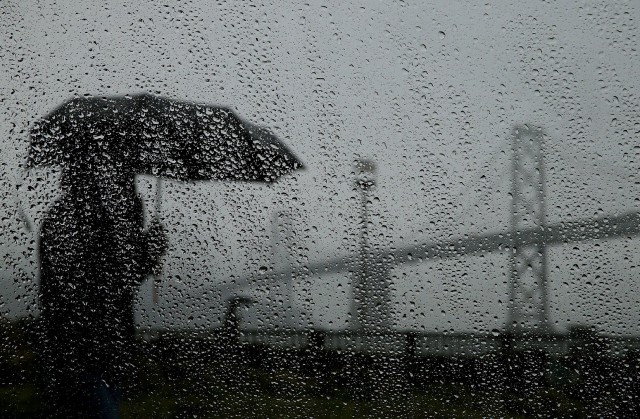Lake Oroville, the main storage facility for the State Water Project and the state's second-biggest reservoir, has seen an increase of 70,000 acre-feet in the last few days. It's still far below normal levels. The state's other major reservoirs saw less impressive gains.
Guarded optimism and outright dejection
So, how you see the last few days depends largely on where you happen to be. Reactions from water agency officials Monday ranged from guarded optimism north of San Francisco Bay, where some areas got a deluge, to outright dejection in the South Bay — an area that was merely brushed by the storm.
The most attention-getting single statistic from the weekend's rain: the 23.51 inches that fell on Mount Tamalpais in Marin County from Wednesday afternoon through Sunday night. That's a mind-boggling total, and more so when you compare it to the amount of precipitation that falls in nearby locations like San Francisco, where the average annual rainfall is just under 21 inches.
That big rain total hints at how Mount Tam is different from the surrounding lowlands. With the right set of conditions, the half-mile-high mountain acts like a sail, catching rain-bearing storm winds coming in from the Pacific. And when those winds are loaded with water, as they were this weekend, lots and lots of rain can fall. That combination of factors makes Mount Tam the key to Marin County's year-round water supply. The Marin Municipal Water District's seven reservoirs all depend on streams that originate on the mountain's slopes.
Before last week, Mount Tam was about as dry as everywhere else in the Bay Area. In January, the mountain's Middle Peak weather station recorded .06 of an inch of precipitation — the same amount of non-rain that fell on downtown San Francisco for the month. The prolonged dry spell, dating back to the beginning of January 2013, meant the Marin district's reservoirs have been dwindling at precisely the time of year they should be rising to brim-full. The district reported last week reservoir levels were down to 53 percent of capacity and 66 percent of normal for this time of year.
And after the storm?
Libby Pischel, public information officer for the MMWD, said 14.76 inches of rain fell at Lake Lagunitas on Mount Tam's north flank. As a result, reservoirs had climbed to 64 percent of capacity on Monday, with runoff still flowing into the district's lakes. That's 76 percent of the normal level for this time of year.
The district has requested a 25 percent voluntary cut in water use from customers, and Pischel says the storm doesn't change that.
"Even though this was a very significant storm and gave us a very significant amount of rain, we do need to be cautious," Pischel said.
She added that MMWD customers who haven't already shut off their landscape irrigation systems ought to do so now. "With this rain, you don't need to irrigate," Pischel said. "Since that's the No. 1 use of water, that will save a lot."
A little relief for Willits
The storm also dumped heavy rain on Willits, a Mendocino County town of 5,000 that's one of 17 communities in the state with critically low water supplies. The city has imposed 35 percent mandatory consumption cuts on all water customers.
Adrienne Moore, the Willits city manager, said the town got 6.61 inches of rain since last Wednesday. That increased the city's water supply, she said, but the town's reservoirs are still at just 25 to 30 percent of capacity.
"It definitely was helpful, but it has not at all pulled us out of a drought yet," Moore said. "We would need to have several similar storms like that to consider the drought a non-issue." She compared the 250 acre feet in water that flowed into Willits' reservoirs to "pouring a cup of coffee into a 5-gallon bucket."
As cautious as water managers sound north of the Golden Gate, at least they saw some meaningful improvement in water supplies over the weekend. That's not the case for the South Bay's biggest water agency, the Santa Clara Valley Water District.
Waiting for the rain gauges to move
Most of the rain stayed well to the north of the valley and its reservoirs, and district spokesman Marty Grimes summarized the impact this way: "Last Thursday, our local reservoir storage was 31.6 percent, and today it's 31.7 percent."
Grimes came across as so disappointed by those numbers that I asked, "Are you as bummed out as you sound?"
He laughed. "I was looking at the rain gauges and reservoir gauges all weekend long, and I was waiting to see them respond," he said. "And I was looking at that Doppler radar map with those nice red and orange waves (signifying heavy rain) going across the North Bay, and it just made me more and more dejected to see we weren't getting any in the South Bay, or very little."
The Santa Clara Valley district has asked users for a 10 percent voluntary cutback in water consumption. With the district heavily dependent on water supplies from the Sacramento-San Joaquin Delta that will be severely curtailed this year, he urged customers to consider steps like planting drought-tolerant plants. He also had a request.
"We would like to have the next series of storms directed our way, if you can manage that," he said.
